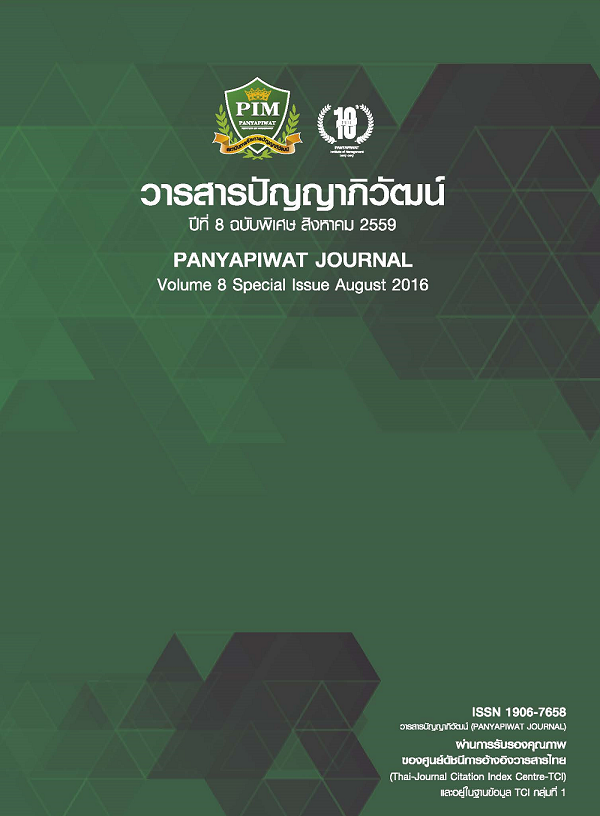คุณลักษณะและช่องทางการสื่อสารการตลาด ผ่านสื่อสังคมออนไลน์ของธุรกิจสปาในจังหวัดภูเก็ต
Main Article Content
บทคัดย่อ
การสื่อสารการตลาดผ่านสื่อสังคมออนไลน์เป็นช่องทางการสื่อสารที่มีศักยภาพสำหรับการประกอบธุรกิจในปัจจุบัน ซึ่งการศึกษาครั้งนี้มีวัตถุประสงค์เพื่อศึกษาถึงคุณลักษณะของการสื่อสารทางการตลาดและระดับการรับรู้ช่องทางการสื่อสารทางการตลาดผ่านสื่อสังคมออนไลน์ของธุรกิจสปาในจังหวัดภูเก็ต และหาความสัมพันธ์ระหว่างคุณลักษณะของการสื่อสารทางการตลาดและระดับการรับรู้ช่องทางการสื่อสารทางการตลาดผ่านสื่อสังคมออนไลน์ของธุรกิจสปาในจังหวัดภูเก็ต ซึ่งใช้ระเบียบวิธีวิจัยเชิงปริมาณ โดยมีแบบสอบถามเป็นเครื่องมือในการศึกษาจากผู้ใช้บริการสปาในจังหวัดภูเก็ต จำนวน 400 คน และเลือกใช้สถิติในการวิเคราะห์แบบถดถอยเชิงพหุ ทั้งนี้ผลการวิจัยพบว่า คุณลักษณะของการสื่อสารทางการตลาดที่มีอิทธิพลต่อระดับการรับรู้ช่องทางการสื่อสารทางการตลาดผ่านสื่อสังคมออนไลน์ของธุรกิจสปาในจังหวัดภูเก็ต มีเพียง 2 คุณลักษณะ ได้แก่ ด้านการสื่อสาร และด้านการตอบสนองระดับบุคคล (sig < 0.05) แต่คุณลักษณะอื่นๆ ไม่ได้มีอิทธิพลต่อระดับการรับรู้ช่องทางการสื่อสารทางการตลาดผ่านสื่อสังคมออนไลน์ของธุรกิจสปาในจังหวัดภูเก็ต
The marketing communication via social medias, nowadays, was the potential channel for business. The objectives were to study of characteristics of marketing communication and the levels of perception in marketing communicative channel via social medias for spa businesses in Phuket. In addition it was also to find the relationship between characteristics of marketing communication and the levels of perception in marketing communicative channel via social medias for spa businesses in Phuket. Quantitative method was used to study and Questionnaires were tool for gathering data from 400 spa customers in Phuket. Multiple regressions were selected to analyze the data. For the purpose that there were two characteristics; Interactive and Individualization, affected to the levels of perception in marketing communicative channel via social medias for spa businesses in Phuket (sig< 0.05) but others characteristics were not affect to the levels of perception in marketing communicative channel via social medias for spa businesses in Phuket.
Article Details
“ข้าพเจ้าและผู้เขียนร่วม (ถ้ามี) ขอรับรองว่า บทความที่เสนอมานี้ยังไม่เคยได้รับการตีพิมพ์และไม่ได้อยู่ระหว่างกระบวนการพิจารณาลงตีพิมพ์ในวารสารหรือแหล่งเผยแพร่อื่นใด ข้าพเจ้าและผู้เขียนร่วมยอมรับหลักเกณฑ์การพิจารณาต้นฉบับ ทั้งยินยอมให้กองบรรณาธิการมีสิทธิ์พิจารณาและตรวจแก้ต้นฉบับได้ตามที่เห็นสมควร พร้อมนี้ขอมอบลิขสิทธิ์บทความที่ได้รับการตีพิมพ์ให้แก่สถาบันการจัดการปัญญาภิวัฒน์หากมีการฟ้องร้องเรื่องการละเมิดลิขสิทธิ์เกี่ยวกับภาพ กราฟ ข้อความส่วนใดส่วนหนึ่งและ/หรือข้อคิดเห็นที่ปรากฏในบทความข้าพเจ้าและผู้เขียนร่วมยินยอมรับผิดชอบแต่เพียงฝ่ายเดียว”
เอกสารอ้างอิง
กรมสนับสนุนบริการสุขภาพ. (2555). ผู้ดำเนินการสปาเพื่อสุขภาพ. กรุงเทพฯ: กรมสนับสนุนบริการสุขภาพ.กระทรวงสาธารณสุข. (2556). คู่มือธุรกิจสปา. กรุงเทพฯ: กระทรวงสาธารณสุข.
กัลยา วานิชย์บัญชา. (2554). สถิติสำหรับงานวิจัย. กรุงเทพฯ: สำนักพิมพ์แห่งจุฬาลงกรณ์มหาวิทยาลัย.
การท่องเที่ยวแห่งประเทศไทย. (2553). พฤติกรรมและความพึงพอใจของนักท่องเที่ยวชาวต่างชาติกลุ่มสุขภาพและความงาม. กรุงเทพฯ: การท่องเที่ยวแห่งประเทศไทย.
เขมณัฏฐ์ มิ่งศิริธรรม. (2556). Social Media สื่อสร้างสรรค์เพื่อการศึกษา. Veridian E-Journal SU, 6(1), 72-81.
เครือวัลย์ ชัชกุล. (2549). หลักการสื่อสารการตลาด. กรุงเทพฯ: มหาวิทยาลัยราชภัฏวไลยอลงกรณ์.
จิตติมา จารุวรรณ์ และอรกัญญา โฆษิตานนท์. (2555). พฤติกรรมและปัจจัยสำคัญจากการสื่อสารการตลาดที่มีต่อการซื้อผลิตภัณฑ์ของผู้บริโภคจากการสื่อสารการตลาดในรูปแบบสื่อสังคมออนไลน์. วารสารปัญญาภิวัฒน์,3(2), 38-49.
ปิยะ วราบุญทวีสุข. (2553). สังคมออนไลน์กับการทำธุรกิจ: แนวทางการทำการตลาด. วารสารนักบริหาร,30(2), 181-185.
ราชบัณฑิตยสถาน. (2556). สื่อสังคม. สืบค้นเมื่อ 4 ตุลาคม 2556, จาก http://www.royin.go.th/สถาบันพัฒนาวิสาหกิจขนาดกลางและขนาดย่อม. (2556). การจัดทำยุทธศาสตร์และแผนปฏิบัติการส่งเสริมวิสาหกิจขนาดกลางและขนาดย่อม. กรุงเทพฯ: สถาบันพัฒนาวิสาหกิจขนาดกลางและขนาดย่อม.
สมชาย วรกิจเกษมกุล. (2554). ระเบียบวิธีการวิจัยทางพฤติกรรมศาสตร์และสังคมศาสตร์. (พิมพ์ครั้งที่ 3). อุดรธานี: อักษรศิลป์การพิมพ์.
สำนักงานพัฒนาธุรกรรมทางอิเล็กทรอนิกส์ (องค์การมหาชน). (2556). รายงานผลการสำรวจพฤติกรรมผู้ใช้อินเทอร์เน็ตในประเทศไทย ปี 2556. รายงานการวิจัย, สำนักงานพัฒนาธุรกรรมทางอิเล็กทรอนิกส์ (องค์การมหาชน).
อธิป อัศวานนท์. (2553). Twitter, Facebook และ YouTube: กลยุทธ์การทำการตลาดและสร้างสรรค์แบรนด์ด้วยนวัตกรรม Social Web. Competitive Review, 5, 28-35.
อรวรรณ วงศ์แก้วโพธิ์ทอง. (2553). Social Media เครื่องมือเพิ่มศักยภาพทางธุรกิจ. วารสารนักบริหาร, 30(4), 63-69.
Cheung, C. M. K. & Lee, M. K. O. (2010). A Theoretical Model of Intention Social Action in Online Social Networks. Decision Support Systems, 49(1), 24-30.
Cheung, C., Chiu, P. & Lee, M. (2010). Online Social Networks: Why do Student Use Facebook?.Computer in Human Behavior, 27, 1337-1343.
Heikkinen, H. (2012). Social Media and Internet Marketing’s Influence on Decision Making Process of German Nature Tourists. Bachelor’s Thesis in International Business, Oulu University of Applied Sciences.
Kietzmann, J. H., Hermkens, K., McCarthy, I. P. & Silvestre, B. S. (2011). Social media? Get serious! understanding the functional building blocks of social media. Business Horizons, 54(3), 241-251.
Ranjha, A. (2010). Promoting Tourism in Abu Dhabi Using Social Media. Master’s Thesis in Media Technology, Royal Institute of Technology.
Sab, J. (2011). Online Advertising in the Tourism Industry and Its Impact on Consumer: A Study to Investigate Online Advertising Tools, the Degree of Usage and Customer Preferences. Tourism and Management Studies, 7, 101-107.
Vidovic, A. (2012). Exploiting the Opportunities Arising Out of Social Media: A Case Study of Hotel in Vienna. Bachelor’s Thesis in Business Administration, Modul Vienna University.
Translated Thai References
Atsavanon, A. (2010). Twitter, Facebook and YouTube: Strategy Marketing and Brand Creative with Social Web. Competitive Review, 5, 28-35. [in Thai]
Chatchakul, K. (2009). Principle of Marketing Communication. Bangkok: Valai-alongkron Rajabhat University. [in Thai]
Department of Health Support. (2012). Health Spa for Manager. Bangkok: Department of Health Support. [in Thai]
Electronic Translations Development Agency (Public Organization). (2013). Thailand Internet User Profile 2013. Research,Electronic Translations Development Agency (Public Organization).[in Thai]
Institute of Development Small and Medium Enterprise. (2013). Strategic and Objective Plan for Development Small and Medium Enterprise. Bangkok: Institute of Development Small and Medium Enterprise. [in Thai]
Jaruwan, J. & Kositanon, O. (2012). Behavior and Key Marketing Communication Factors that Influence Purchasing Behavior from Social Media Marketing Communication. Panyapiwat Journal, 3(2), 38-49. [in Thai]
Mingsiritham, K. (2013). Social Media: Creative Media for Education. Veridian E-Journal SU, 6(1), 72-81. [in Thai]
Ministry of Public Health. (2013). Spa Business Manual. Bangkok: Ministry of Public Health. [in Thai]Office of the Royal Society. (2013). Social Media. Retrieved October 4, 2013, from http://www.royin.go.th/ [in Thai]
Tourism Authority of Thailand. (2010). Behavior and Satisfaction of Foreigner Tourist: Health and Beauty. Bangkok: Tourism Authority of Thailand. [in Thai]
Vanichbuncha, K. (2011). Statisitic for Research. Bangkok: Chulapress. [in Thai]
Varaboontavisuk, P. (2010). Social Media and Business: Guideline to Do Marketing. Executive Journal, 30(2), 181-185. [in Thai]
Vorakitkasemkul, S. (2011). Research Methodology in Behavior and Social Science (3rd ed.). Udonthani: Aksornsilkarnpim. [in Thai]
Wongkeawphotong, A. (2010). Social Media Tool for Adding Potential. Executive Journal, 30(4), 63-69. [in Thai]


